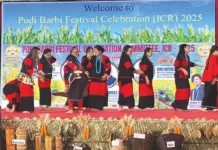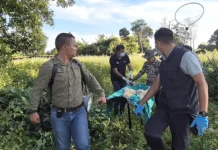[ Prem Taba ]
My PhD fieldwork in the remote Puroik villages like Rawa, Pohbey, Yakli, Sangchu, Satuk, Dungkho, Yakli, and Sangchu have been an eye-opening experience, filled with encounters that painted a complex picture of a community in transition.
While the scars of a historical master-slave relationship remain etched deep, there are also glimmers of hope for a brighter future.
One encounter, etched deeply in my memory, was with an elderly woman. Her voice trembled as she spoke of their abysmal living conditions. Their ‘masters’ addressed as ‘maalik’ (Hindi) or ‘atoh’ (Nyishi), took a hefty cut of their earnings, leaving them with a pittance. Construction sites, with roads now snaking through the mountains, had become their forced labour grounds. The ‘masters’ would subcontract work and exploit them further. Men toiled, cutting canes and timber, sold later by their masters in faraway towns. Barely enough was left to buy salt, let alone nourish their families. Even livestock reared with immense effort could be seized to feed visiting masters. Government support schemes, such as rehabilitation assistance funds, remained just that – a distant promise. “On paper, it’s good,” she sighed, “but here in reality, it’s a different story.”
This harsh reality contrasted sharply with the official narrative of abolished slavery and government initiatives. The Bonded Labour System (Abolition) Act, 1976, surveys to liberate bonded labourers, the Puroik Autonomous Board, rehabilitation villages, and welfare schemes – all seemed like distant pronouncements in the face of their daily struggles.
The beginning of my fieldwork, in March last year, brought me to Lada headquarters, about 130 kilometres from Seppa. There, I met a young Puroik boy named Mangtang Peo. He was staying with my nephew, March Sangtung, a teacher, who had kindly offered him a room. Mangtang, around 15 years old, was a bright student in Class 6 at the Govt Upper Primary School (GUPS) here. His village, Peo, was a strenuous hour-and-a-half climb down a steep slope and across the Pachuk river from Lada. The descent mirrored the arduous trek I had done earlier that year in Dzukou valley. However, unlike Dzukou’s well-maintained porter tracks, Peo’s path was a muddy trail carved by hand. Mangtang explained that his father and the village elders had built this treacherous trail to allow their children to access education in Lada, which symbolised their yearning for a better future.
A hanging bridge, constructed in 2018, provided a vital connection across the the Pachuk river. Before that, villagers relied on makeshift cane rope bridges, a testament to their resourcefulness and the challenges they faced. Mangtang also revealed a historical injustice. His actual surname was Brrai, but due to lack of education and awareness, not only his family but the entire village of Peo had been wrongly designated as Peo. He expressed a desire to reclaim his rightful surname, even if it seemed strange, considering his parents’ surnames were Peo.
After reaching Peo, we conducted data collection, and in his free time, Mangtang became my enthusiastic guide. He led me to his favorite spots – streams, rivers, and mostly mountains. Fishing was clearly a passion, and he tried to impress me with his skills using both cast netting and traditional techniques. Unfortunately, that day, and surprisingly, many other Puroik youths we met by the river, returned empty-handed. Despite the lack of luck, Mangtang and I managed to catch two Himalayan trouts with the cast net. In the evening, I met Mangtang’s siblings – Isiah and Jamsi – his younger sisters, and Kalo, his little brother. His parents and a few guests were also present. Two of the guests, Nyishis, seemed to be there for business with Mangtang’s aunt (his mother’s sister). The conversation, held near the fireplace, hinted at a power dynamic favouring the Nyishis. Not wanting to pry, I observed silently. Later, Mangtang’s mother prepared a delicious local dish called charap, made from rangbang, or sago palm. Peo lacked electricity and telecommunication facilities. Recognising their need, I gifted two walkie-talkies, originally meant for fieldwork, to Mangtang’s father. His delight and gratitude were heart-warming. The remaining two walkie-talkies were passed on to Mangtang the next day before we departed for Lada. While Peo marked the end of my fieldwork, the walkie-talkies would hopefully be a valuable tool in their isolated village.
The next morning, after another breakfast of rangbang and tea, I promised Mangtang’s mother that I would help tutoring him and ensure his academic success. Mangtang also played a crucial role in my data collection efforts in nearby Puroik villages like Kojo, Rojo, Jarkam, Nasamjan, Prrik, Satuk, and Dungkho. The Puroik people, by nature, tend to be reserved and unfamiliar with modern interactions. Starting conversations was often challenging, with shyness leading to limited responses. Mangtang’s presence, however, bridged this gap. He translated my questions into Puroik, facilitating a more open exchange of information. To lighten the mood and encourage participation, we distributed cake and sweets to the children and respondents. One humorous encounter occurred in Kojo village. An elderly man, upon seeing us approach, bolted, fearing arrest by the police. Mangtang’s calm conversation in Puroik clarified our intentions, and the man, visibly relieved, interacted with us. He revealed that he was born before the 1962 Sino-India war. We reassured him with a friendly gesture – offering him cake and patiently explaining our purpose.
My conversations with Mangtang also uncovered the financial struggles he faced in pursuing his education. He rarely received money from his parents, with his highest ever amount being a mere 3,000 rupees. Their own financial constraints left him largely dependent on my nephew, March Fachang, who provided accommodation and pocket money sometimes. Living with a teacher like my nephew offered a distinct advantage – Mangtang received additional academic support. He would sometimes help out with chores like washing dishes to express his gratitude. Supplementing his income, he occasionally participated in cultural performances at political events and VIP gatherings. He described one instance where a group of boys, including himself, were invited to entertain a group of engineers and contractors camped in their village during road construction towards Tawe village. In exchange for dancing for eight hours, the group was promised payment. However, several months passed before an elder from their village delivered a meagre sum of 3,000 rupees, to be divided among the 30 boys, amounting to a mere 100 rupees each. He also resorted to odd jobs to raise money, carrying timber from deep jungles, cutting cane bamboos, assisting with construction work, and even selling wild meat and the fish he caught.
On our final night in Lada, at my nephew’s teacher quarters, I cautiously raised the issue of bonded labour with Mangtang, concerned about his family’s situation mirroring the experience of the elderly woman I had met earlier. He confirmed that they did have a Miji (Sajolang tribe) master, but their relationship had evolved over time. The exploitative dynamic of the past had softened, with a more relaxed and independent arrangement. While relieved to hear this, I emphasised the importance of seeking help if they ever faced exploitation or coercion. I also explained their legal rights in detail. That night, Mangtang revealed another disheartening reality – the exploitation of his own village by educated elders. He explained how these individuals devised schemes to defraud the villagers, particularly concerning finances. Community funds received from various sources were allegedly pocketed by these “educated” individuals, who, due to their connections with officials, companies, and other public leaders, could manipulate the flow of funds. Mangtang expressed his determination to break this cycle. He vowed to use his education to empower himself and his community, bringing positive change and development to Peo.
As my fieldwork concludes, I carry with me a burning ember of hope ignited by the spirit of Peo village. Limited exposure often restricts Puroik aspirations, typically focused on fulfilling basic needs like catching more fish, felling larger trees, and hunting bigger animals. However, it’s important to avoid generalisations. Throughout my study, I’ve encountered numerous Puroik individuals who defied these limitations, achieving higher education in prestigious colleges across the country in diverse fields like medical science, agriculture, engineering, law, and beyond.
Determined to broaden Mangtang’s horizons and expose him to the possibilities of higher education and the modern world, I, with his parents’ and elder brother’s blessing, am taking him along to Itanagar. There, I plan to introduce him to the opportunities beyond his village – educational institutions, modern life, and inspiring role models from his own community. This exposure trip, I hope, will spark a fire within him, a burning desire to learn, to become empowered and be an agent of positive change within his society. My fervent wish is that his dreams just don’t die away in Lada or Peo. Life, I pray, will treat him fairly, allowing him to become a blazing torch for change, a person who can lead the Puroik people into the right direction.



